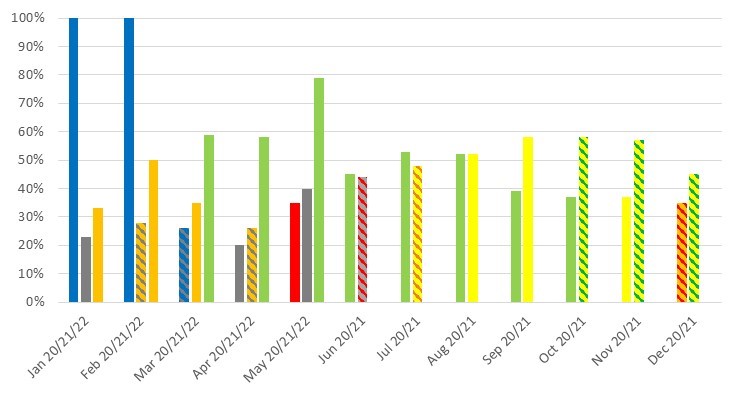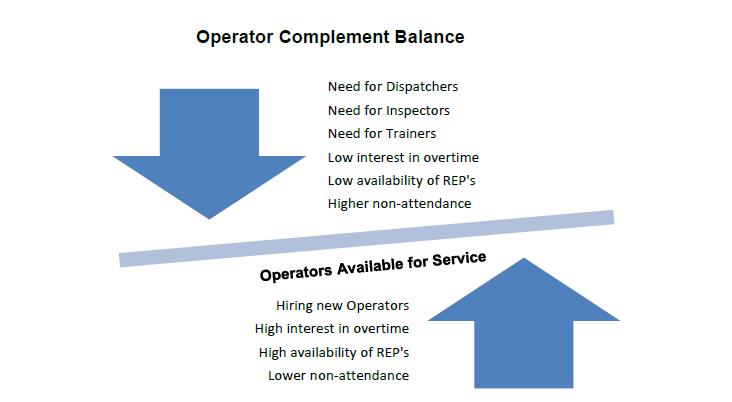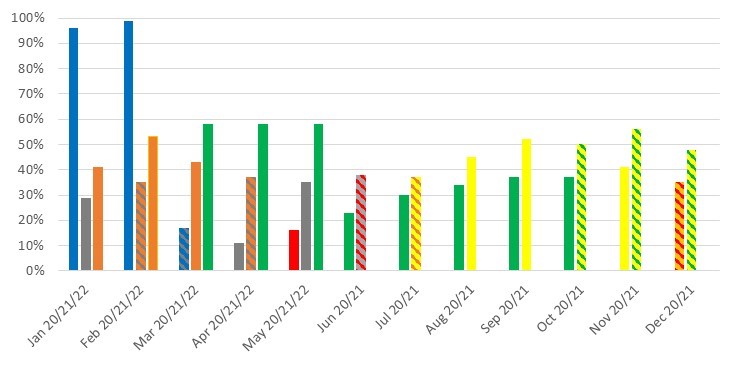Staff Report #2
June 21, 2022
To All Members of the Accessible Public Transit Service Advisory Committee
Re: COVID-19 Ridership and Service Impacts
Recommendation
The report be NOTED and FILED.
Background
The pandemic declaration in March of 2020 and associated lockdown measures that have followed have resulted in declines in transit ridership on both the conventional and specialized services. Each new wave of the pandemic has resulted in varying levels of public health measures, including lockdowns in some cases. In addition to the impacts on ridership, London Transit has experienced numerous other impacts that have impacted the ability to deliver service and work program initiatives as planned.
As the remainder of this report will illustrate, London Transit, consistent with transit systems across the country, finds itself if the eye of a perfect storm. While ridership levels are returning with many buses carrying standing loads, employee resource and supply chain issues are limiting the ability to increase service levels in response. The remainder of the report will discuss each of these elements in greater detail.
Conventional Transit
Ridership
The organizational philosophy adopted at the onset of the pandemic with respect to service levels was to ensure that all areas of the city that were served by transit would continue to be served, albeit at lesser frequencies based on employee resource availability.
The graph below provides an overview of the ridership levels on the conventional service for 2021 and 2022 to date with comparative data for 2020, both as a percentage of what would normally be expected in each month noting the numbers are based on actual boardings as counted by the automatic passenger counters on buses. The bars are coloured to match the various stages of lockdown as noted below:
Green Prevent – no, very limited restrictions in place
Yellow Protect & Stage 3 under the current re-opening plan – very limited restrictions in place
Orange Restrict & Stage 2 under the current re-opening plan – limited restrictions in place
Red Control & Stage 1 under the current re-opening plan – numerous restrictions in place
Grey Lockdown – full lockdown restrictions in place
The colour blue in the graphic is used for January and February 2020 given the pandemic declaration had not occurred at that point in time. Bars that are striped indicate a change during the month from the base colour to the striped colour.
2020, 2021 and 2022 Conventional Transit Weekday Ridership as a % of Normal

The above graph clearly depicts the impacts that the various stages of lockdown have on conventional transit service ridership. As indicated in the graph, weekday ridership in May rebounded to approximately 80% of normal. It should be noted that this graph is depicting ridership as a percentage of normal in each month, and ridership numbers for the period of May through August are traditionally lower than the rest of the year given the post-secondary students are not attending school during this period. Of interest, weekend ridership in May rose to in excess of 100% of normal pre-pandemic levels for the spring service period, which is problematic given the shortage of resources required to increase service levels.
The signup period beginning May 1, 2022 was set to return to full service levels and begin to implement the 2021 service improvements (noting the conventional service had been operating at approximately 90% of normal service levels since September 2020). Unfortunately continued higher than anticipated non-attendance rates resulted in numerous runs being cancelled during the first week of May. In an effort to ensure a more reliable service for customers, the decision was made to once again cease the operation of the Express Routes 90, 91, 92 and 94 until such time as the available employee complement has improved. This approach provides for the availability of a pool of Operators to fill in for sick calls which mitigates the need to cancel one-off runs. Notwithstanding these measures, there have still been occasions where additional runs have had to be cancelled and in these cases, the corporate social media accounts are utilized to remind riders to rely on the real-time information versus the static schedule information.
Employee Resource Requirements – Operations
Over the past several months, focus has been directed toward increasing the Operator complement in an effort to reach the required complement level to return to full service levels and begin to implement service improvements. While good progress has been made, and it was believed the complement level had reached the required level to support the service improvements, a number of other issues which impact the ability to meet service came to light when the new schedules took effect.
As the graphic below indicates, there are a number of factors that can impact the actual Operator complement that is required to deliver the service as scheduled. Factors including the need for Dispatcher and Inspector reliefs, Operator Trainers, desire for overtime by the group at large, the level and average duration of non-attendance and the availability of the retired Operator group that works on a casual basis (REP’s) are all considered when calculating the required complement.
The primary focus of the Operator complement is to perform the duties of the bus Operator; however, this group is also relied upon to provide coverage in the Dispatch and Inspector roles during time of absence (both short and long term). Permanent vacancies in these groups are also generally filled from the Operator complement. In addition, the trainers who conduct both the classroom and on-road training for new Operator recruits are also part of the Operator complement, as such, increased class sizes results in fewer Operators available for service as more have to act as trainers to complete the onboarding process for the new recruits. Factors relating to the willingness of the group to work overtime, the availability of REP’s and the levels of non-attendance are factored in, based on historical experience. As the graphic below depicts, changes in any one of these factors can impact the required complement, and should that shift result in downward pressure on the total complement number, there is a likelihood that service will not be met on a regular basis.
Operator Complement Balance

The past two years of operating through the pandemic has influenced every factor that affects the Operator complement; unfortunately, impacts in all areas have been such that they have placed downward pressure on the total complement that is available for service in the primary role of Bus Operator. Retirements in the Inspector and Dispatch groups has resulted in the need for additional Operators to be trained and utilized to fill relief roles and the hiring of two Operator Trainers for Supervisory roles has resulted in the need to recruit and train two new Trainers. Over the past two years, there has also been a significant decline in the availability of part-time REP Operators as well as an interest in working overtime among the Operator group at large. Finally, the non-attendance levels, both in terms of the number and duration of instances has increased significantly. Each wave of the pandemic has resulted in unpredictability in terms of the number of absences at any given time, but the longer-term impacts of the pandemic in terms of delayed surgical and other treatments required for employees to be able to return to work has also significantly impacted the duration of non-attendance in many cases. When applying this factor to the complement calculation, caution must be exercised as employees in this category are likely to return to full and normal duties at some time, and as such, cannot simply be replaced on a one-for-one basis as this could result in an over-complement situation which places significant pressure on the operations labour budget.
Given the above impacts, coupled with the continued difficulties in meeting service post-May 1, 2022 when the new schedules took effect, administration is undertaking a recalculation to arrive at a new Operator complement number that is reflective of the current factors. This new number will be utilized in determining the appropriate timing of any additional service changes and will ensure that appropriate resources are available in order to avoid any route/run cancellations going forward.
Work continues with respect to the onboarding of Operators with a class of seven that began training on May 16, 2022 followed by a class of six that began June 13, 2022. While work continues in an effort to fill future classes, the number of applicants in the pool as well as those applying have both declined significantly, which could result in difficulties filling classes going forward. In light of the ongoing difficulties meeting service as scheduled, a second signup for the period beginning June 26, 2022 has been completed that would see a return to the 90% service levels that had been in place prior to May 1, 2022.
Employee Resource Requirements – Fleet and Facilities
The complement in the Fleet and Facilities area is split between skilled labour (technicians, bodymen, painters, engineers) and general service labour. While the complement calculation for each of these groups is not as complicated as that for the Operator group, certain thresholds must be maintained in each area to ensure that buses can be maintained and serviced in a manner that ensures the required number of buses are available for service each day. Over the past two years, approximately 10% of this workforce has retired or resigned. Recruitment for these vacancies early on in the pandemic was successful primarily due to other employers closing or downsizing as the result of the pandemic; however, the current conditions in the labour market have changed significantly and recruitment has become extremely problematic. There are currently two skilled labour positions open and posted, with no applicants. In addition to the vacancies resulting from retirement, a number of employees in this department are also off work longer than what would be considered normal, primarily as the result of delays relating to the pandemic.
Administration has been addressing these shortfalls through moving people between the Highbury and Wonderland facilities, moving tasks between shifts, and offering overtime. While these approaches have had success thus far, the appetite for overtime will decline over the summer months as this is prime vacation time. Should these complement levels not be addressed through recruitment in the coming months the ability to ensure the required number of buses each day for service may be impacted.
An enhanced push on recruitment for all open positions is being undertaken, with advertising on recruitment sites as well as on the corporate socials and website. In addition, consideration for other forms of advertising is underway and will continue to be assessed and utilized over the coming months in an effort to fill vacancies.
Supply Chain Issues
Over the past number of months, supply chain issues have, to varying extents, impacted the ability to service and maintain the conventional fleet.
The availability of transmission fluid for buses continues to be a concern noting some progress has been made with respect to the identification of options moving forward. Administration continues to work with alternative suppliers of transmission fluid as well as the engine manufacturer in an effort to identify a solution that will not impact the engine warranty.
Each year, approximately 17 to 20 buses have their engines replaced as part of the regular maintenance cycle. This work is usually undertaken in the first half of the year. Engines are ordered in August of the prior year in order to ensure delivery and provide appropriate time to complete the work. To date, nine buses have undergone engine replacement and one is awaiting the replacement engine. In early May, the engine supplier advised that the remaining seven engines which were ordered in August 2021 would not be delivered as scheduled. They are unable to provide a delivery date at this time. While this work is considered to be part of the regular maintenance schedule, buses scheduled for engine replacement this year will continue to be utilized for regular service for as long as possible. Should an engine fail, the bus will need to parked until such time as the outstanding engines arrive and work can resume. Extended delays have the potential to result in up to seven buses being unavailable for service.
In late April, New Flyer advised that, due to a global computer chip shortage and the need for same for the Multiplex Module on board the bus, delivery of both the 2022 replacement and expansion buses is likely to be delayed. The most recent update from New Flyer indicates this shortage is anticipated to be a problem until at least August. There have been updates with respect to when LTC buses are expected to be delivered. With respect to the replacement buses, administration has developed a strategy to keep the required number of buses in the fleet in order to maintain service levels. Depending on the extent of the delay, this could result in additional and unbudgeted costs to repair buses that are currently parked and scheduled for retirement. Coupled with the delay associated with the replacement engine delay, bus availability is likely to be a concern in the fall.
Delay of the delivery of the five expansion buses will have a greater impact on service, as it will limit the ability to implement the 2022 service improvements in September should the buses not be available and ready for service. Under normal circumstances, buses scheduled to be retired could be kept in service for a few extra months to compensate for the delay in expansion buses; however, given the delay in replacement bus delivery coupled with the costs associated with repairing buses that will be retired in the very short term, this approach may not be feasible for 2022. This issue will be closely monitored in the coming months and updates will be provided.
Specialized Transit
Ridership
The graph below provides an overview of the ridership levels on the specialized service for 2021 and 2022 to date, with comparative data for 2020 as a percentage of what would normally be expected in each month. Consistent with the earlier graph, the colours in the various bars are reflective of the stages of lockdown that were in place at the time.
2020, 2021 and 2022 Specialized Transit Ridership as a Percent of Normal

As the graph indicates, ridership levels to date for March through May 2022 surpassed the previous pandemic-period high from November 2021. Administration will continue to monitor trip demand by time of day and day of week, and gradually increase service hours to meet demand.
Service
As indicated above, administration is continuing to monitor service demand and will work with the contracted service provider to increase service levels as demand warrants. The only issue with respect to making these adjustments relates to the service provider’s ability to secure drivers to meet the increased service requirements.
Corporate Communications
Over the coming months, communication will be paramount in order to ensure that riders have the most up to date and accurate information regarding service, and also have an understanding of the issues being faced and the steps being taken to address them. Should the aforementioned issues result in the need to reduce services or delay service improvements, it will be imperative that all stakeholders understand the reasons behind the decisions as well as the plans to mitigate the issues going forward and communications will be focused on sharing this information.
The corporate website, socials and stop-level notices will continue to be utilized, as appropriate, to provide up to date service information including service interruptions, detours etc. to keep customers informed with respect to current issues and plans going forward.
As previously mentioned, with respect to vacancies and ongoing recruitment, in addition to advertising on recruitment sites as well as on the corporate socials and website, consideration for other forms of advertising is underway and will continue to be assessed and utilized over the coming months in an effort to fill vacancies.
Internally, information screens will continue to be utilized to ensure that employees are informed of the issues being faced and the plans to address them.
Recommended by:
Katie Burns, Director of Finance
Mike Gregor, Director of Planning
Craig Morneau, Director of Fleet & Facilities
Joanne Galloway, Director of Human Resources
Concurred in by:
Kelly S. Paleczny, General Manager